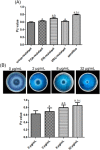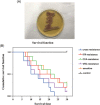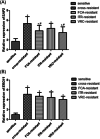The effects of secreted aspartyl proteinase inhibitor ritonavir on azoles-resistant strains of Candida albicans as well as regulatory role of SAP2 and ERG11
- PMID: 33951330
- PMCID: PMC8342201
- DOI: 10.1002/iid3.415
The effects of secreted aspartyl proteinase inhibitor ritonavir on azoles-resistant strains of Candida albicans as well as regulatory role of SAP2 and ERG11
Abstract
Background: Candida albicans, the main human fungal pathogen, can cause fungal infection and seriously affect people's health and life. This study aimed to investigate the effects of ritonavir (RIT) on C. albicans and the correlation between SAP2 as well as ERG11 and drug resistance.
Results: Secreted aspartyl proteinases (Saps) activities and pathogenicity of C. albicans with different drug resistance were measured. M27-A4 broth microdilution method was used to analyze the drug sensitivity of RIT combined with fluconazole (FCA) on C. albicans. After that, SAP2 and ERG11 mutations were examined by polymerase chain reaction (PCR) and sequencing, and quantitative real-time PCR was utilized to determine the expression of the two genes. By analyzing pz values, the Saps activity of cross-resistant strains was the highest, followed by voriconazole (VRC)-resistant strains, FCA-resistant strains, itraconazole (ITR)-resistant strains, and sensitive strains. The pathogenicity of C. albicans in descending order was as follows: cross-resistant strains, VRC-resistant strains, ITR-resistant strains, FCA-resistant strains, and sensitive strains. With the increase of RIT concentrations, the Saps activity was gradually inhibited. Drug sensitivity results showed that there was no synergistic effect between RIT and FCA. Additionally, no gene mutation sites were found in SAP2 sequencing, and 17 synonymous mutations and 6 missense mutations occurred in ERG11 sequencing. Finally, the expression of SAP2 and ERG11 was significantly higher in the resistant strains compared with the sensitive strains, and there was a positive liner correlation between SAP2 and ERG11 messenger RNA expression (r = .6655, p < .001).
Conclusion: These findings may help to improve our understanding of azole-resistant mechanisms of C. albicans and provide a novel direction for clinical therapeutics of C. albicans infection.
Keywords: Candida albicans; ERG11; SAP2; secreted aspartyl proteinases.
© 2021 The Authors. Immunity, Inflammation and Disease published by John Wiley & Sons Ltd.
Conflict of interest statement
The authors declare that there are no conflict of interests.
Figures



Similar articles
-
Mutations and/or Overexpressions of ERG4 and ERG11 Genes in Clinical Azoles-Resistant Isolates of Candida albicans.Microb Drug Resist. 2017 Jul;23(5):563-570. doi: 10.1089/mdr.2016.0095. Epub 2016 Dec 15. Microb Drug Resist. 2017. PMID: 27976986
-
Relationships between Secreted Aspartyl Proteinase 2 and General Control Nonderepressible 4 gene in the Candida albicans resistant to itraconazole under planktonic and biofilm conditions.Braz J Microbiol. 2023 Jun;54(2):619-627. doi: 10.1007/s42770-023-00961-z. Epub 2023 Apr 22. Braz J Microbiol. 2023. PMID: 37087512 Free PMC article.
-
Nucleotide substitutions in the Candida albicans ERG11 gene of azole-susceptible and azole-resistant clinical isolates.Acta Biochim Pol. 2013;60(4):547-52. Epub 2013 Dec 16. Acta Biochim Pol. 2013. PMID: 24340302
-
Screening for amino acid substitutions in the Candida albicans Erg11 protein of azole-susceptible and azole-resistant clinical isolates: new substitutions and a review of the literature.Diagn Microbiol Infect Dis. 2010 Apr;66(4):373-84. doi: 10.1016/j.diagmicrobio.2009.11.006. Diagn Microbiol Infect Dis. 2010. PMID: 20226328 Review.
-
[Azole resistance in Candida spp].Nihon Ishinkin Gakkai Zasshi. 2003;44(2):87-92. doi: 10.3314/jjmm.44.87. Nihon Ishinkin Gakkai Zasshi. 2003. PMID: 12748589 Review. Japanese.
Cited by
-
Construction of Candida albicans pRB895-SAP2-SC5314 With SAP2 High Expression and Its Effects on Adhesion.J Clin Lab Anal. 2025 Jan;39(2):e25144. doi: 10.1002/jcla.25144. Epub 2024 Dec 27. J Clin Lab Anal. 2025. PMID: 39727206 Free PMC article.
-
Investigation of the relationship between fluconazole susceptibility, proteinase activity and ERG11-SAP2 Expression in Candida albicans strains isolated from clinical samples.Curr Med Mycol. 2024 Dec 31;10:e2024.345311.1585. doi: 10.22034/cmm.2024.345311.1585. eCollection 2024. Curr Med Mycol. 2024. PMID: 40662151 Free PMC article.
-
Staphylococcus aureus wraps around Candida albicans and synergistically escapes from Neutrophil extracellular traps.Front Immunol. 2024 Jul 10;15:1422440. doi: 10.3389/fimmu.2024.1422440. eCollection 2024. Front Immunol. 2024. PMID: 39050841 Free PMC article.
-
Repurposing HIV Protease Inhibitors Atazanavir and Darunavir as Antifungal Treatments against Candida albicans Infections: An In Vitro and In Vivo Study.Curr Issues Mol Biol. 2022 Nov 1;44(11):5379-5389. doi: 10.3390/cimb44110364. Curr Issues Mol Biol. 2022. PMID: 36354676 Free PMC article.
-
Roles of Nucleolar Factor RCL1 in Itraconazole Resistance of Clinical Candida albicans Under Different Stress Conditions.Infect Drug Resist. 2024 Feb 27;17:769-777. doi: 10.2147/IDR.S431024. eCollection 2024. Infect Drug Resist. 2024. PMID: 38433785 Free PMC article.
References
Publication types
MeSH terms
Substances
LinkOut - more resources
Full Text Sources
Other Literature Sources

